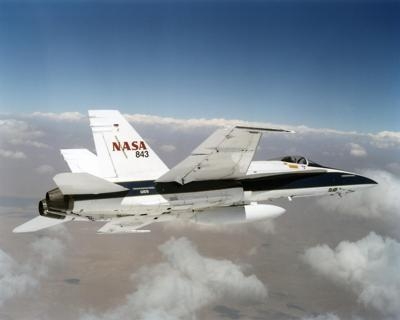Reducing Sonic Booms Is The 'Most Significant Hurdle'
The return of supersonic passenger travel may be coming closer to reality thanks to NASA’s efforts to define a new standard for low sonic booms.

Several NASA aeronautics researchers will present their work in Atlanta this week at Aviation 2014, an annual event of the American Institute of Aeronautics and Astronautics. They will share with the global aviation community the progress they are making in overcoming some of the biggest hurdles to supersonic passenger travel.
The research generates data crucial for developing a low-boom standard for the civil aviation industry. NASA works closely with the Federal Aviation Administration and the international aerospace community, including the International Civil Aviation Organization, to gather data and develop new procedures and requirements that may help in a reconsideration of the current ban on supersonic flight over land.
"Lessening sonic booms -- shock waves caused by an aircraft flying faster than the speed of sound -- is the most significant hurdle to reintroducing commercial supersonic flight," said Peter Coen, head of the High Speed Project in NASA's Aeronautics Research Mission Directorate at the agency's Headquarters in Washington. "Other barriers include high altitude emissions, fuel efficiency and community noise around airports."
Engineers at NASA centers in California, Ohio and Virginia that conduct aviation research are tackling sonic booms from a number of angles, including how to design a low-boom aircraft and characterize the noise. NASA researchers have studied how to quantify the loudness and annoyance of the boom by asking people to listen to the sounds in a specially designed noise test chamber.
A recent flight research campaign at NASA's Armstrong Flight Research Center in Edwards, California, had residents explore ways to assess the public’s response to sonic booms in a real-world setting. Researchers at Armstrong have an advantage -- pilots are permitted to fly at supersonic speeds because the facility is located on Edwards Air Force Base. "People here are more familiar with sonic booms," said Armstrong aerospace engineer Larry Cliatt. "Eventually, we want to take this to a broader level of people who have never heard a sonic boom."
Similar work is conducted at NASA's Langley Research Center in Hampton, Virginia, where volunteers from the local community rated sonic booms according to how disruptive they determined the sound to be. "They each listened to a total of 140 sounds, and based on their average response, we can begin to estimate the general public's reactions," explained Langley acoustics engineer Alexandra Loubeau.
She also conducted a study at Langley comparing results from tools used to predict sonic boom noise at ground-level. “Because of the interaction with the atmosphere, it is important to be as consistent as possible in the implementation and usage of these tools. The comparisons done so far have shown good agreement, but there are some inconsistencies that need to be studied,” Loubeau said.
Other studies are focused on predicting the sonic boom and on design approaches to reducing it. Participants from Japan, the United States and France attended the first Sonic Boom Prediction Workshop, where they evaluated simple configurations -- cylindrical bodies with and without wings -- and complex full aircraft designs. "We are working to understand the worldwide state of the art in predicting sonic booms from an aircraft point of view," said Mike Park, a fluid mechanics engineer at Langley. "We found for simple configurations we can analyze and predict sonic booms extremely well. For complex configurations we still have some work to do."
Wind tunnels are another tool used to help predict which airplane designs might have quieter booms. The most recent tests were conducted at NASA's Ames Research Center in Moffett Field, California, and Glenn Research Center in Cleveland. Similar to designs of the past, current aircraft designs being tested are characterized by a needle-like nose, a sleek fuselage and a delta wing or highly-swept wings -- shapes that result in much lower booms.
NASA and industry engineers say they believe supersonic research has progressed to the point where the design of a practical low-boom supersonic jet is within reach.
(Image provided by NASA. NASA F/A-18 mission support aircraft were used to create low-intensity sonic booms during a research project at the agency's Armstrong Flight Research Center in Edwards, California)
 ANN's Daily Aero-Term (04.24.24): Runway Lead-in Light System
ANN's Daily Aero-Term (04.24.24): Runway Lead-in Light System ANN's Daily Aero-Linx (04.24.24)
ANN's Daily Aero-Linx (04.24.24) Aero-FAQ: Dave Juwel's Aviation Marketing Stories -- ITBOA BNITBOB
Aero-FAQ: Dave Juwel's Aviation Marketing Stories -- ITBOA BNITBOB Classic Aero-TV: Best Seat in The House -- 'Inside' The AeroShell Aerobatic Team
Classic Aero-TV: Best Seat in The House -- 'Inside' The AeroShell Aerobatic Team Airborne Affordable Flyers 04.18.24: CarbonCub UL, Fisher, Affordable Flyer Expo
Airborne Affordable Flyers 04.18.24: CarbonCub UL, Fisher, Affordable Flyer Expo



